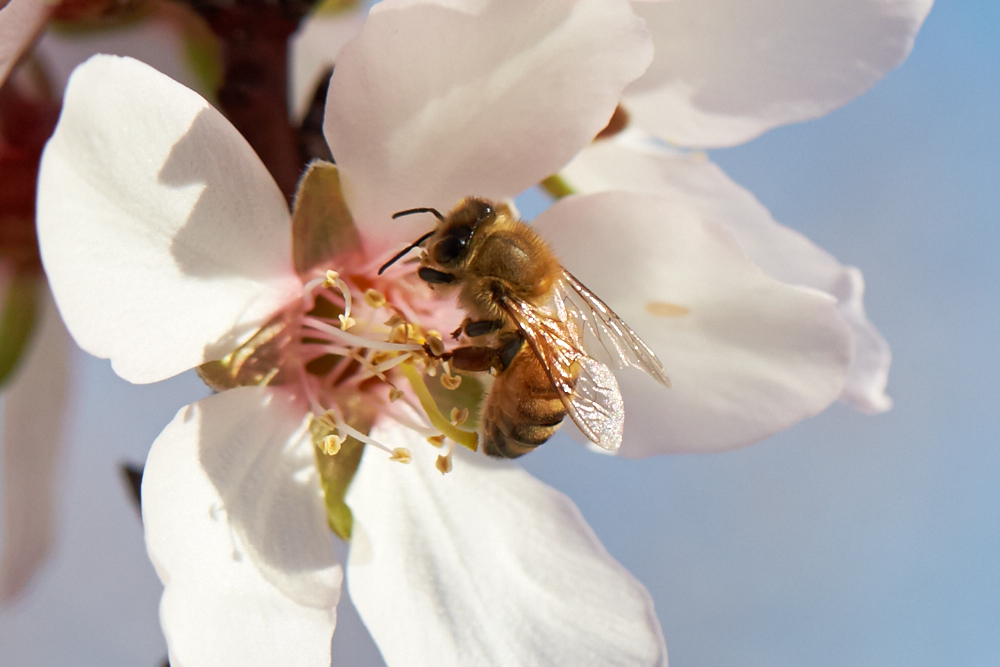
Bloom and bees. The symbiotic relationship is essential to our industry and requires a careful balance between managing yield-robbing diseases, insects and weeds while protecting honey bees from potentially harmful pest control materials.
Enter the Almond Board of California (ABC)’s Honey Bee Best Management Practices (BMPs) for California almonds. ABC recently refreshed the BMPs, which were first released in 2014, and incorporated new tips and resources that growers and other stakeholders can use to protect honey bees and plan for a productive pollination.
One key aspect of maintaining honey bee health is only applying pesticides during bloom if they are absolutely necessary. Here are eight useful tips to keep in mind as you consider your spray schedule:
-
Communication about pest control decisions should occur between all pollination stakeholders. These stakeholders, as illustrated in the Communication Chain in the “Honey Bee Best Management Practices for Almonds,” can include the beekeeper, county agricultural commissioner, grower, pest control advisor (PCA) and pesticide applicator.
-
Contact beekeepers 48 hours before pesticide application. The responsible individual (i.e., applicator) should notify contracted beekeepers and any beekeepers within 1 mile of the application site. That individual should also use electronic crop management programs, or contact their local county agricultural commissioner directly, to locate hives within a 1-mile radius of the spray site. This advanced warning is mandatory for products with “toxic to bees” on the label statement and recommended for all other applications, particularly during bloom.
-
Avoid applying insecticides during bloom. Insecticides can impact bee adults and brood (young developing bees in the hive). The one exception for application is Bacillus thuringiensis (Bt), for which the safety of adult and immature bees is documented. If treatment is necessary, only apply fungicides and avoid tank mixing insecticides with fungicides.
-
Any fungicide application deemed necessary during bloom should occur in the late afternoon or evening, when bees and pollen are not present. This timing avoids contaminating pollen with spray materials. Also, be cautious about adjuvants. The University of California recommends adjuvants should not be used with fungicides during bloom unless stated on the label.
-
Provide clean water for the bees to drink to ensure they spend more time pollinating the crop than searching for water. Beekeepers and growers should decide who will provide clean water, a practice that includes covering or removing water sources for bees before a pest control treatment or emptying and refilling water after a treatment is made. The responsible individual should also check water levels throughout bloom and refresh as necessary.
-
Do not directly spray hives with any pesticide application. Ensure that the spray-rig driver turns off nozzles when near hives. If a spray application comes in contact with bee hives, it could adversely affect bee health and overall pollination of the crop.
-
Do not hit flying bees with any spray application materials. Bees that come in contact with agricultural sprays will not be able to fly due to the weight of spray droplets on their wings.
-
Report suspected pesticide-related honey bee incidents to the county agricultural commissioner’s office as soon as possible. Bee health concerns cannot be addressed without the data from these incidents. When reporting, include notes describing the previous health of the colony, prevailing wind, EPA registration number from the suspected pesticide label, name of the suspected pesticide and how the bees may have been exposed to the pesticide.
The Almond Board’s Honey Bee BMPs were developed with input from the almond community, beekeepers, researchers, UC Davis, California and U.S. regulators, and chemical registrants. Download the full guide, as well as the Honey Bee BMP Quick Guide and Honey Bee BMP Quick Guide for Applicators, here.


